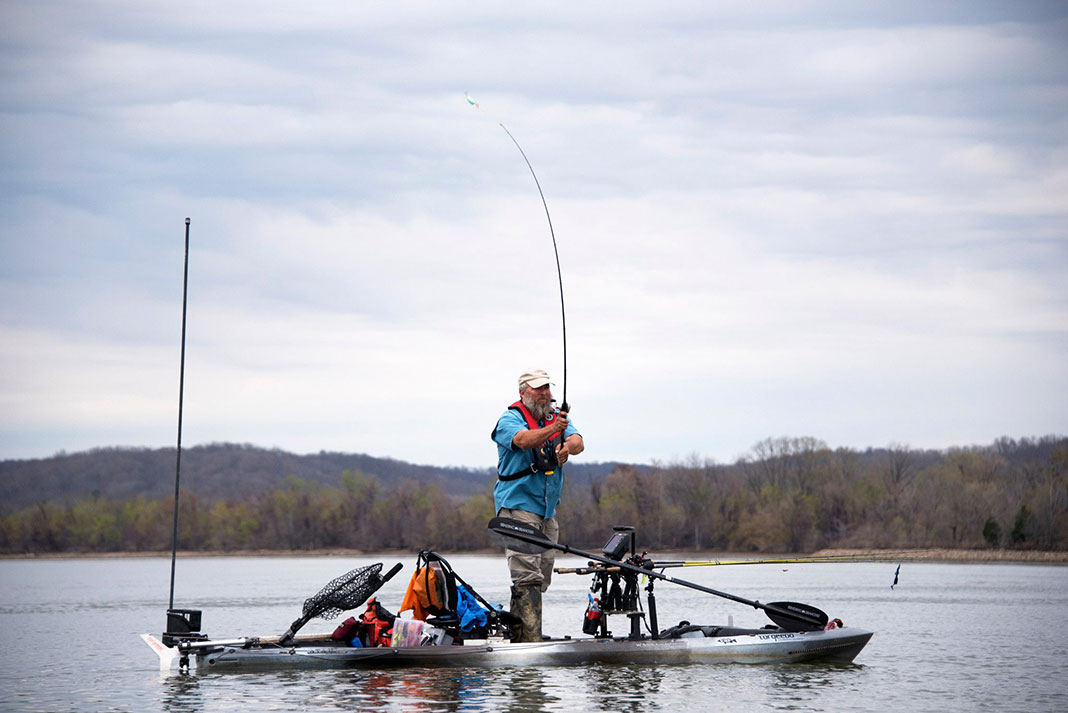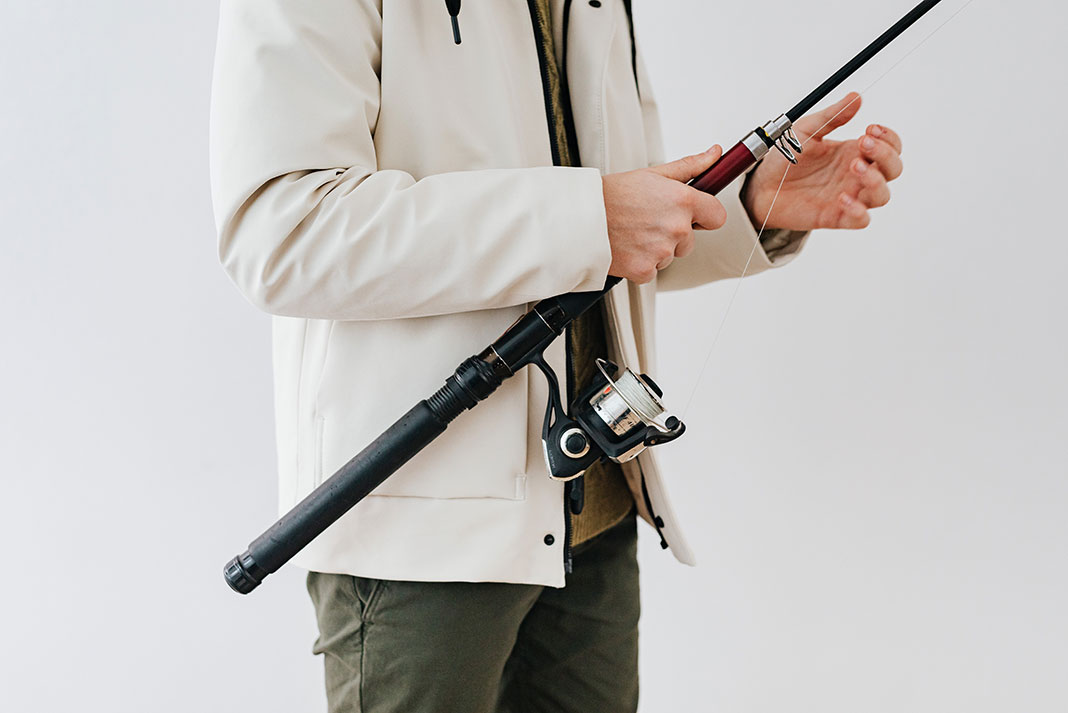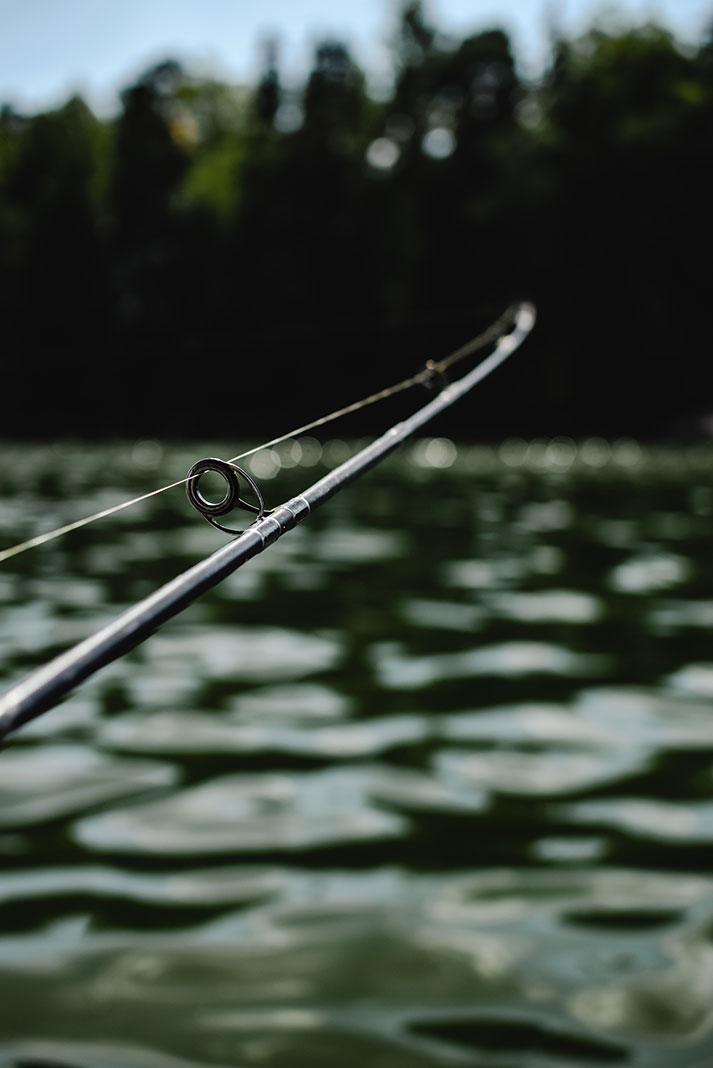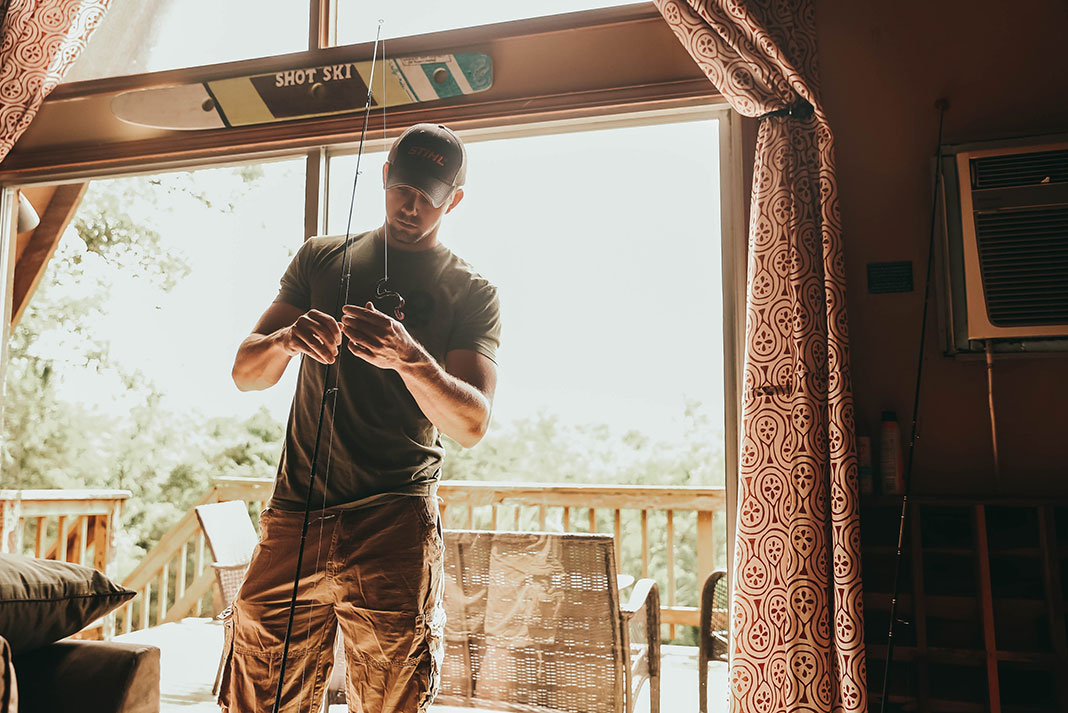How To Set Up Weight On Fishing Pole
50earning how to set up a fishing pole is a picayune like learning to bulldoze—once you know how to do it, setting up a fishing rod will become second nature. While the process is simple, the variety of rods, reels and line tin be disruptive. The adept news is, y'all tin can discover a perfect combo for the fishing you do.
There are thousands of different sizes and styles, and so the showtime footstep is choosing the right rod for the type of fishing you lot plan to do. Then, friction match information technology with the best size and way of reel. Next, make full the reel with the all-time fishing line for the fish you target and thread the line through the fishing pole. Finally, tie on a lure or rig and you lot're in business. Read on for more details on how to set up a fishing pole.
How to Assemble Your Fishing Rod
How to Choose a Fishing Rod
Fishing rods come in lengths from ii feet to over 12. Deportment range betwixt actress ultra-light to extra ultra-heavy. And at that place is a angling rod to handle everything from a diminutive brook trout to an explosive blue marlin. When deciding how to prepare a fishing pole, the first stride is to consider the angling you program to do.
SHOP Angling RODS ON AMAZON
While there are many specialized rods for a specific species or tactic, at that place are also great options for an all-around fishing rod. When setting up a fishing rod for kayak line-fishing, choose the best fishing rod possible. Life in a kayak is tough on a angling rod and reel, to ensure reliable performance, a high-quality rod and reel combo will pay off in the long run.
In general, the fishing rod, reel and line should friction match the size of the fish you programme to target. A line-fishing rod'southward performance is labeled nearly the reel. First, the rod is measured with ii qualities: strength and action. A heavy rod with a moderate activeness volition be more than powerful while a lighter rod with a faster tip is more sensitive. The characterization often includes recommended line test and lure weight along with the length of the rod. A longer fishing rod will cast farther and a shorter rod provides more than lifting power when fighting a fish.

Most angling rods are fabricated of fiberglass or graphite. Fiberglass line-fishing rods are tougher while graphite fishing rods are light and sensitive. Rod eyes also come in many styles and materials, await for the toughest line guides to survive banging around in a pocket-size plastic gunkhole.
Then there are spinning rods and baitcasting rods. Spinning rods have the line guides on the underside with the offset eye significantly larger than the rod tip center. Baitcasting rods put the eyes on height and usually have a trigger at the reel seat to improve grip.
Both types of rod can perform whatsoever blazon of fishing. While baitcasters and spinners each have their platonic use, the choice comes down to personal preference. In general, baitcasting rods offer more power and command while spinning rods tend to exist more sensitive and easier to work some lures.
All this information makes the selection equally clear every bit a mud puddle. For starting time anglers, a seven-pes, medium-action spinning rod volition handle everything from bluegill and largemouth bass to redfish and striped bass.
Parts of a Line-fishing Rod
From butt to tip, a fishing rod is built to be tough and sensitive. The long, flexible rod must deliver a lure with pinpoint accurateness, twitch the bait simply correct, set the hook with authority and beat out a wild animate being into submission.
The butt is the thick end of the fishing rod. Heavy fishing rods feature a gimble that fits securely into a rod holder or a fighting chugalug. Moving upward, the reel handle and foregrip is either foam or cork. Cork is more than sensitive, simply foam can exist tougher and more grippy.

The reel attaches to the line-fishing rod at the reel seat. Some reel seats have an open space that exposes the rod blank for actress sensitivity.
The rod bare is the backbone. Fishing rods are fabricated past wrapping fiberglass or graphite fabric around a mandrel then covering with liquid and curing until hard. The thickness and quality of the materials determines the rod's power and weight.
Rod eyes or guides are ofttimes disregarded until they intermission or crack leaving the rod useless. The eyes are fastened to the line-fishing rod past wrapping their feet in layers of thread. Rods with hard, ceramic inserts are best for braided line. Metal optics will last longer but crusade more friction on the line. As you ready a fishing pole, always cheque rod guides for wear and harm, a cleaved or missing eye could put the rod out of service.
How to Ready a Fishing Reel
How to Choose a Reel
Fishing reels are astonishing works of grade and function. Built from the most advanced materials with high-tech design, these metal and composite cranking machines are a work of art and functioning.
SHOP FISHING REELS ON AMAZON
There are many types of reels, but most autumn into 2 categories: spinning reels or baitcasting reels. Each has its advantages and platonic utilise.
Spinning reels hang beneath the rod and use a wire bail to guide the line on the spool. A baitcasting reel sits on top the rod and winds the line onto the spool like a winch. The general dominion of pollex is spinning reels are for lighter baits where sensitivity is important. Baitcasting reels are favored for casting heavier lures with more than accuracy. Spinning reels are a little easier to use, but modern baitcasting reels forbid tangles acquired by overrun line assuasive y'all to choose the best reel for the tactic you employ most.
For spinning and casting reels, at that place is broad variation in size labels between manufactures. I company's 2500 may hold equally much line equally some other company'south 4000. To lucifer the size of the reel to the size of the reel, expect for manufacturer's recommendations.
To set a fishing rod, try the reel on the rod to see if information technology balances well and looks proportionate. Or, look for a rod and reel combo set upwardly by the manufacturer. Many combos will come up with line, too. But advanced anglers like to lucifer their favorite reel to their favorite rod, outside of manufacture or brand, to get the performance they need. To fix up a line-fishing pole, utilize the rod and reel combination that meets the size of lure or weight you volition utilize.
For more data on angling reels and how to choose the right one, see our article on v Types Of Fishing Reels Explained.
Parts of a Reel
A line-fishing reel consists of 4 principal parts: spool, gears, drag and body. The spool holds line, the handle works the gears to plough the spool and remember line and the drag allows line to exit the spool when a fish pulls. The quality of these parts directly affects the performance of the reel. Any reel volition bring a fish to the gunkhole. Over fourth dimension these parts will get-go to deteriorate and somewhen fail. The all-time reels prolong this procedure for more happy days on the h2o.
How to Cull Fishing Line
Line-fishing line is the Achilles heel of the rod and reel philharmonic. After all the rigging and casting, success comes downward to a big fish on the cease of a thin fishing line.
Store FISHING LINE ON AMAZON
In that location are three chief types of angling line: monofilament, braided line and fluorocarbon. Monofilament is made of a single strand of nylon fiber. Monofilament stretches more fluorocarbon or complect, making it good for fighting a big fish. It also has retentiveness, keeping its shape even when loose, so it doesn't tangle every bit easily.

Braided line is made of multiple strands of thinner line weaved together. This process creates a line that is softer, stiffer and thinner. Braided line is favored past many anglers considering it casts farther and is more sensitive. Braid also sinks faster and cuts through vegetation. Information technology is more expensive than monofilament, just it lasts longer.
Fluorocarbon is a single strand of a material that is stiffer and tougher than monofilament. Fluoro as well has the same light refraction as water, then it appears invisible below the surface. Anglers like fluorocarbon for leader material considering it survives abrasion and the fish tin can't see information technology.
Line strength is measured in the pounds it will concord without breaking. A 20-pound-test line will intermission under 20-pounds of force per unit area. While all fishing lines are measured with the aforementioned test, each type of line has its strengths and weaknesses. Monofilament will stretch before information technology breaks, making it adept for large fish that fight hard. Fluorocarbon is stiffer and harder than mono, assuasive information technology to absorb abrasion earlier breaking. Braided line is thinner and stronger than monofilament or fluorocarbon. For example, 30-pound test braided line is the same diameter as 10-pound test monofilament. Simply braided line line does not stretch, so it is less abrasion resistant.
While there are many ways to grab a fish, anglers targeting everything from largemouth bass to striped bass are using braided line with a short, 12-inch, department of fluorocarbon or monofilament leader between the mainline and the hook. This ready-up provides the casting distance and sensitivity of braid with the stretch and depression visibility of monofilament or fluorocarbon.
Go into greater depth on your options in our Angler's Guide To Types Of Fishing Line.
How to Put Fishing Line on a Reel
To spool a reel with fishing line, start with the fishing reel on the rod. Thread the line through the top eye of the rod through the commencement eye. Wrap a slice of electrical tape effectually the spool arbor before tying on the fishing line. The tape volition keep the line from spinning on the spool. Tie the fishing line to the arbor with an arbor knot.
Next, wrap one mitt around the rod blank but below the beginning middle. Pinch the line with a rag or paper towel to apply maximum friction to the line without called-for your fingers.
Concur the line spool with a pencil through the heart, then stick it betwixt your knees while you crank line onto the reel. The line should leave the spool the same management it is going on the reel. If the line starts to twist, turn the spool over and continue to crank line onto the reel.
Finally, turn the reel handle with the reverse hand to fill the spool with line. Exist certain to keep force per unit area on the line and then information technology winds tightly on the spool. Fill the spool to an ane/8 of an inch from the lip. Secure the line to the spool with a rubber band or piece of record until you are ready to fish.
How to Thread a Angling Rod
Threading fishing line through a rod is piece of cake, but there are a few tips to brand it easier.
To string a angling pole, start with the line in one hand and the rod in a rod holder. If a rod holder is not available, concur the rod with your opposite mitt only above the reel. Instead of opening the bail or releasing the clutch on the reel, loosen the elevate to release line. Using the drag keeps pressure on the line so it doesn't loop or tangle while you are threading line through the guides.

Be certain to thread the line through each rod eye. While you are threading the line, audit the eyes for cracks, fries or other harm. Once the line is through each eye and the elevation center pull off enough line to achieve the reel again. Necktie a loop in the end of the line and attach information technology to the reel handle to keep the line from tangling.
How to Adhere Lures to a Fishing Line
There are many types of lures and many means to attach them to your fishing line. Some anglers tie a snap to the end of their line to make switching lures fast and piece of cake, but the stealthiest style to tie on a lure is directly to the line. Utilise a few feet of heavier monofilament or fluorocarbon leader between the lure and the mainline for actress forcefulness. For example, if you are fishing 10-pound test on your reel you should add 12 inches of 20-pound leader with a line-to-line knot, then necktie on the lure.
SHOP FISHING LURES ON AMAZON
How to Choose a Lure
Smaller, lighter lures volition work all-time tied directly to light fishing line. Heavier fish require heavier line and leader. Topwater anglers prefer fluorocarbon leader because it floats. Deepwater lures work best with braided line that cuts through the h2o and transmits every vibration from the fish. Monofilament is best for trolling lures because it stretches to blot the fish's strike.
Finesse lures favor braided line for its sensitivity and thin diameter, merely many anglers are going with fluorocarbon lines which are nearly invisible to the fish. Friction match the weight and type of line-fishing line to the lure you plan to apply. For the virtually part, 12-pound, clear monofilament tied directly to the lure will take hold of 90 pct of fish in the globe.
How to Tie a Lure to Your Line
The best knot for fishing is the knot you know best. To tie a lure to your line, anglers have a lot of options. Since they all work, choose the easiest to necktie and learn information technology well. The number one avoidable angler error is a poorly tied knot. When choosing a knot to tie your lure to your line, consider a couple things.

Monofilament and fluorocarbon are the best for tying knots. Braided line is glace, then it requires a knot that cinches on itself, like a Palomar or uni-knot. Many anglers add a short leader to their mainline with a line-to-line knot, a uni-to-uni-knot connectedness works with whatsoever type of fishing line. Always use a scissors to cut fishing line. Pair of scissors are safer, quicker, and more accurate than a knife.
For more info on the options to necktie your tackle together, see our Angler's Guide To Fishing Line Knots.
How to Adjust the Elevate
The rod is assembled, the line is spooled and threaded through the guides and the lure is on the end of the line. The last affair to do earlier you lot get fishing is set the elevate on the reel.
Drag force per unit area allows the line to go out the reel even when the gears are engaged. A series of discs between the reel handle and the gears allows the spool to turn and allow out line even when the reel is engaged. You can adjust the amount of pressure level on the discs by rotating a punch on the reel. Too picayune drag will let the fish go away while too much drag volition break the line or pull the hook. The perfect residual is setting the drag at one-third the breaking force of the line.
So, if you are using 15-pound mainline, prepare the drag at five pounds. Decide the drag pressure level by placing the rod in a rod holder and pulling on the end of the line with a mitt scale. If you don't have a hand scale, fix the drag tight enough for a fish to pull line when it is making a strong run.
Learning how to prepare up a fishing pole is a trivial like learning to drive. | Feature photo: Oliver Schlotfeldt/Pexels
Source: https://kayakanglermag.com/stories/tackle/how-to-set-up-a-fishing-pole/

0 Response to "How To Set Up Weight On Fishing Pole"
Post a Comment